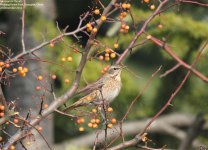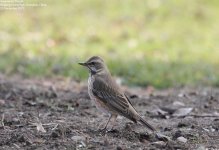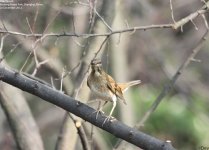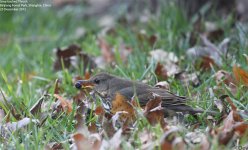-
Welcome to BirdForum, the internet's largest birding community with thousands of members from all over the world. The forums are dedicated to wild birds, birding, binoculars and equipment and all that goes with it.
Please register for an account to take part in the discussions in the forum, post your pictures in the gallery and more.
You are using an out of date browser. It may not display this or other websites correctly.
You should upgrade or use an alternative browser.
You should upgrade or use an alternative browser.
China observations (14 Viewers)
- Thread starter Gretchen
- Start date
More options
Who Replied?Question on tit migration
So little time to get out these days, and when I do I'm mostly trying to distinguish members of one of my less favored groups (ducks).... so not a lot of interest to share.
I do have a small puzzle. I started wondering, why is it that tits (mostly Great, but I've seen coal too, and there may be others) come to our campus in the winter? We are a ways from "mountains", and a mile from forested areas (which I would think they would prefer to our more populated area). Are tits altitudinal migrants (coming lower in winter)? But we really hardly have altitude in the area. Or are they coming down from the north? Is there something drawing them to our campus rather than the forest (some kinds of trees they find more prey on)? or?
Any thoughts?
So little time to get out these days, and when I do I'm mostly trying to distinguish members of one of my less favored groups (ducks).... so not a lot of interest to share.
I do have a small puzzle. I started wondering, why is it that tits (mostly Great, but I've seen coal too, and there may be others) come to our campus in the winter? We are a ways from "mountains", and a mile from forested areas (which I would think they would prefer to our more populated area). Are tits altitudinal migrants (coming lower in winter)? But we really hardly have altitude in the area. Or are they coming down from the north? Is there something drawing them to our campus rather than the forest (some kinds of trees they find more prey on)? or?
Any thoughts?
Thanks Mark!
We do have an excellent supply of spiders (and webs) in our gardens - they seem to thrive here! I hadn't thought about our micro-climate. Guess it is a bit warmer - I always think of the tit-family as pretty hardy, but who wouldn't prefer a slightly warmer location? Actually our buildings are constructed such that there are spaces which could provide excellent windbreaks for birds - but I haven't actually noted any of them (other than tree sparrows) using that feature. I'll have to look more closely. Also, I guess compared with other birds, tits are less people-adverse (and additionally as it gets cold people are outdoors less so it seems a bit less densely populated).
It is true too that they may be more obvious as they are moving and calling more now... In the warmer parts of the year they are pretty obvious at LianFeng Shan though, and I rarely note them here.
It would be fascinating to know if they are basically local or coming down from northern climes! Guess we'll have to wait for ringing to become a more common activity in this part of the world!
We do have an excellent supply of spiders (and webs) in our gardens - they seem to thrive here! I hadn't thought about our micro-climate. Guess it is a bit warmer - I always think of the tit-family as pretty hardy, but who wouldn't prefer a slightly warmer location? Actually our buildings are constructed such that there are spaces which could provide excellent windbreaks for birds - but I haven't actually noted any of them (other than tree sparrows) using that feature. I'll have to look more closely. Also, I guess compared with other birds, tits are less people-adverse (and additionally as it gets cold people are outdoors less so it seems a bit less densely populated).
It is true too that they may be more obvious as they are moving and calling more now... In the warmer parts of the year they are pretty obvious at LianFeng Shan though, and I rarely note them here.
It would be fascinating to know if they are basically local or coming down from northern climes! Guess we'll have to wait for ringing to become a more common activity in this part of the world!
Last edited:
rockfowl
Mark Andrews
Look for subtleties in their plumage, also look out for other species amongst them, Long-tailed Tit for example. I've seen both, well the now Silver-throated Tit, which breeds close-by and the northern White-headed Long-tailed close to you, so wouldn't be surprised if you got a few.
They are pretty tough birds as a group.
They are pretty tough birds as a group.
Disappointingly I haven't seen any long-tailed tits yet :eek!:
Mark, looking to see about the two types you mentioned, the silver throated would be Aegithalos [caudatus] vinaceus and white headed Aegithalos caudatus caudatus? Can anybody link any pictures for them? (I see they aren't really sorted so much at OBC.)
Mark, looking to see about the two types you mentioned, the silver throated would be Aegithalos [caudatus] vinaceus and white headed Aegithalos caudatus caudatus? Can anybody link any pictures for them? (I see they aren't really sorted so much at OBC.)
rockfowl
Mark Andrews
caudatus from Tom, lovely ! - http://orientalbirdimages.org/search.php?Bird_ID=1404
Silver-throated - http://ibc.lynxeds.com/photo/silver-throated-tit-aegithalos-glaucogularis/adult-botanical-garden and one from Dev - http://orientalbirdimages.org/search.php?p=2&Bird_ID=1404&Bird_Family_ID=&pagesize=1
The birds in Hebei for the latter species aren't quite so distinctive but I can't quite remember what it is. Never managed to get any pics of either, restless little souls.
Silver-throated - http://ibc.lynxeds.com/photo/silver-throated-tit-aegithalos-glaucogularis/adult-botanical-garden and one from Dev - http://orientalbirdimages.org/search.php?p=2&Bird_ID=1404&Bird_Family_ID=&pagesize=1
The birds in Hebei for the latter species aren't quite so distinctive but I can't quite remember what it is. Never managed to get any pics of either, restless little souls.
mcaribou
Migration coming
today together with the BPochard,they also saw a male Redhead:eek!:American Wigeon yesterday in Yancheng NR by Paul Holt.
rockfowl
Mark Andrews
Not exactly relevant Mc, but might be of interest - http://www.albaecology.co.uk/birdscot/docs/article2-3.htm
mcaribou
Migration coming
thanks and I found this for both of u Marks
http://www.birdskorea.org/Birds/Identification/ID_Notes/BK-ID-Lesser-Scaup.shtml
http://www.birdskorea.org/Birds/Identification/ID_Notes/BK-ID-Lesser-Scaup.shtml
thirudevaram
Trapped in mist ***s
Mean while, i'm also caught up with Naumann's fever. Plus some usual wintering thrushes from Binjiang Forest Park of Shanghai on the day of Christmas. My first Naumann's :t:
Attachments
Nice thrushes, Dev. I like the orange berries with the first Naumann's (don't know if anyone recognizes them - I'm still trying to figure out and recognize the trees that the thrushes will enjoy in winter here.) The grey-backed is beautiful too - suppose it makes me think of American Robins, but even prettier - and I like how you caught it with the berry in its mouth.
rockfowl
Mark Andrews
The second one looks to have almost no red in the tail - maybe some loose genes in there!
Cheers
Mike
I thought exactly the same Mike, but do 1st winter naumanni always show it? - http://orientalbirdimages.org/birdi...es&Bird_ID=2443&Bird_Family_ID=201&pagesize=1
Last edited:
Users who are viewing this thread
Total: 15 (members: 0, guests: 15)








